better. We have to tell stories. That bulldog riding a skateboard is a curiosity; it is not a story. A story requires structure, theme, mood, plot and characters rather than caricatures. “The art of arousal today has to aim higher. If we are going to entertain, we must do better. We have to tell stories.” Dove’s Real Beauty Sketches film (2013) is a fine example of advertising as storytelling, and vice versa. It embraces the power of narrative, of viewer engagement, of appealing directly to a woman’s sense of empathy. We invited women to sit for a forensic artist and asked them to describe themselves. Their replies exposed a skewed appraisal, one that emphasized their perceived physical flaws. Strangers were then invited to describe the women to the artist, and the appraisals were much more generous, framing the subjects’ looks more holistically and using details other than purely physical. When the two sketches were revealed to each participant, the contrast between their negative self-perception and favourable external view could hardly have been more stark, surprising both to the women and the viewer. The emotional power of that reaction explains why the film has become one of the most watched pieces of advertising in the world. The surprise here is shocking: the difference between how women see themselves, and how others see them. But it’s also profoundly moving. It is dopamine rich. 2. Immersive Content Zen and the Art of Marketing Communications may seem a long way apart, but the Digital Revolution has brought them closer together than you might think. Digitalization had always carried with it the promise of a two-way communication. You, the individual, can be isolated. You can be invited to participate in the dialogue. And then you can join it. And, in joining, you can literally both find yourself and lose yourself. To illustrate, I’ll return to Dove. Imagine that you, a woman, were given the power to change the harmful female stereotypes that had become rote in digital media as
 Ogilvy on Advertising in the Digital Age Page 147 Page 149
Ogilvy on Advertising in the Digital Age Page 147 Page 149